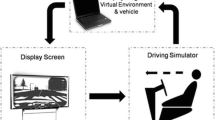Abstract
The prefrontal cortex (PFC) is involved in many complex cognitive functions such as problem-solving, planning, reasoning, and decision-making. However, the biological mechanisms of these computations are not clear. To understand these mechanisms, we theoretically consider the experimental result of a path-planning task by Mushiake et al. using a mathematical model referred to as the potential network model. The simulation results show that our model can take the correct path in most trials, regardless of the goal positions and the block patterns in the task. Furthermore, our model reproduces the characteristics of the neuronal activity in both the PFC and the primary motor cortex. This study reveals that although the potential network model is abstract, it can be useful in modelling higher brain functions.
Similar content being viewed by others
References
Baddeley A (2003) Working memory: looking back and looking forward. Nat Rev Neurosci 4:829–839
Miller EK (2000) The prefrontal cortex and cognitive control. Nat Rev Neurosci 1:59–65
Kosslyn SM (2005) Mental images and the brain. Cogn Neuropsychol 22:333–347
Schultz W, Dayan P, Montague PR (1997) A neural substrate of prediction and reward. Science 275(5306):1593–1599
Unterrainer JM, Owen AM (2006) Planning and problem solving: from neuropsychology to functional neuroimaging. J Physiol Paris 99:308–317
Goel V, Grafman J (2000) Role of the right prefrontal cortex in ill-structured planning. Cogn Neuropsychol 17:415–436
Mushiake H, Saito N, Sakamoto K, et al. (2006) Activity in the lateral prefrontal cortex reflects multiple steps of future events in action plans. Neuron 50:631–641
Mushiake H, Saito N, Sakamoto K, et al. (2001) Visually based path-planning by Japanese monkeys. Cogn Brain Res 11:165–169
Mushiake H, Saito N, Furusawa Y, et al. (2002) Orderly activations of human cortical areas during a path-planning task. Neuroreport 13:423–426
Bachmann CM, Cooper LN, Dembo A, et al. (1987) A relaxation model for memory with high storage density. Proc Natl Acad Sci USA 84:7529–7531
Hopfield JJ (1982) Neural networks and physical systems with emergent collective computational abilities. Proc Natl Acad Sci USA 79:2254–2258
Kauffman SA (1969) Metabolic stability and epigenesis in randomly constructed genetic nets. J Theor Biol 22:437–467
Newell A (1990) Unified theories of cognition. Harvard University Press, Cambridge
Kieras DE, Meyer DE (1997) An overview of the EPIC architecture for cognition and performance with application to human-computer interaction. Human Comput Interact 12:391–438
Dehaene S, Changeux JP (1997) A hierarchical neuronal network for planning behaviour. Proc Natl Acad Sci USA 94(24): 13293–13298
Anderson JR, Bothell D, Byrne MD, et al. (2004) An integrated theory of the mind. Psychol Rev 111:1036–1060
Polk TA, Simen P, Lewis RL, et al. (2002) A computational approach to control in complex cognition. Cogn Brain Res 15:71–83
Newman SD, Carpenter PA, Varma S, et al. (2003) Frontal and parietal participation in problem solving in the Tower of London: fMRI and computational modeling of planning and high-level perception. Neuropsychologia 41:1668–1682
Wood JN, Grafman J (2003) Human prefrontal cortex: processing and representational perspectives. Nat Rev Neurosci 4:139–147
Miller EK, Cohen JD (2001) An integrative theory of prefrontal cortex function. Annu Rev Neurosci 24:167–202
Duncan J (2001) An adaptive coding model of neural function in prefrontal cortex. Nat Rev Neurosci 2:820–829
Fuster JM (2001) The prefrontal cortex — an upate: time is of the essence. Neuron 30:319–333
Author information
Authors and Affiliations
Corresponding author
About this article
Cite this article
Oku, M., Aihara, K. A mathematical model of planning in the prefrontal cortex. Artif Life Robotics 12, 227–231 (2008). https://doi.org/10.1007/s10015-007-0472-6
Received:
Accepted:
Published:
Issue Date:
DOI: https://doi.org/10.1007/s10015-007-0472-6




